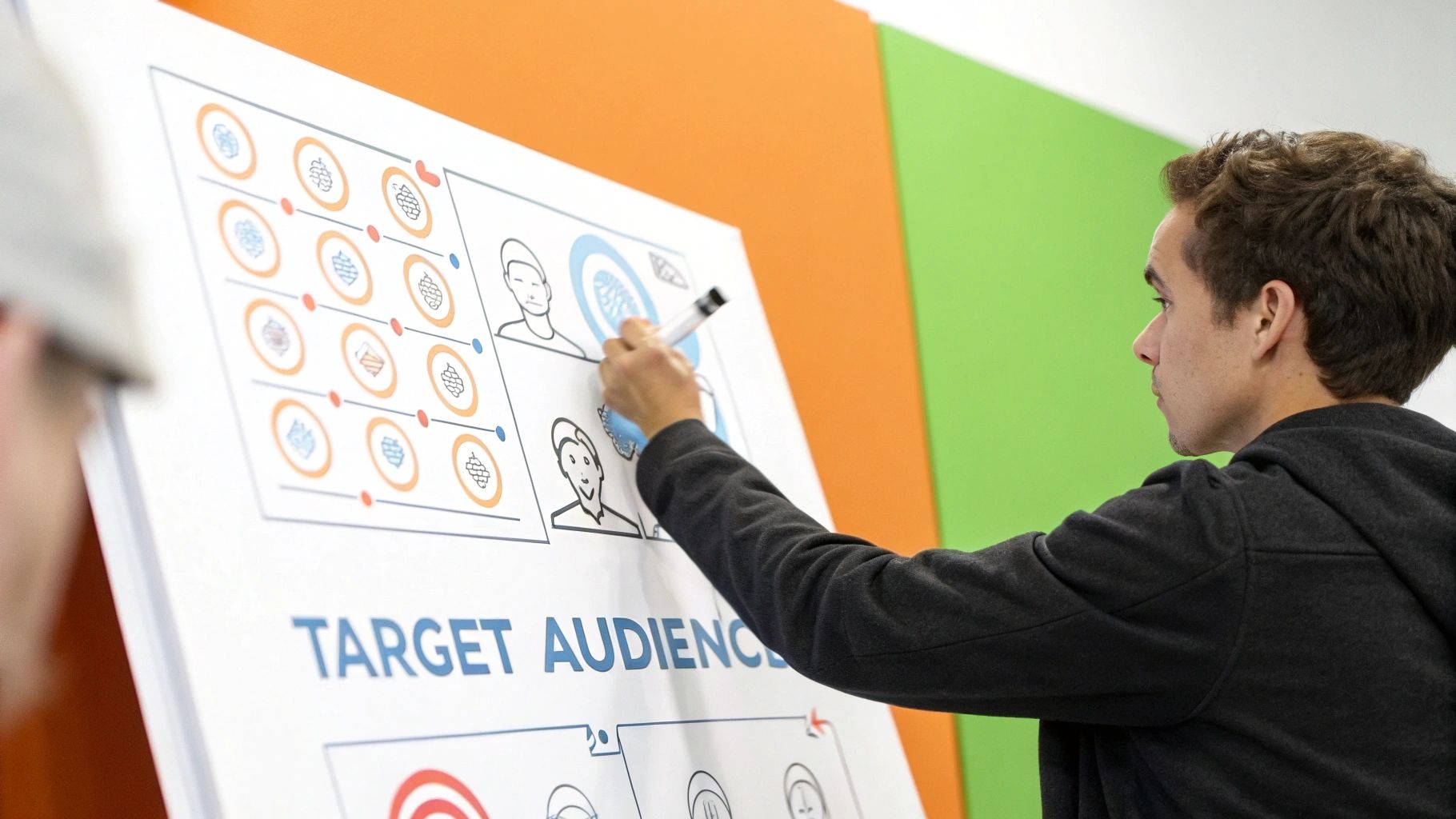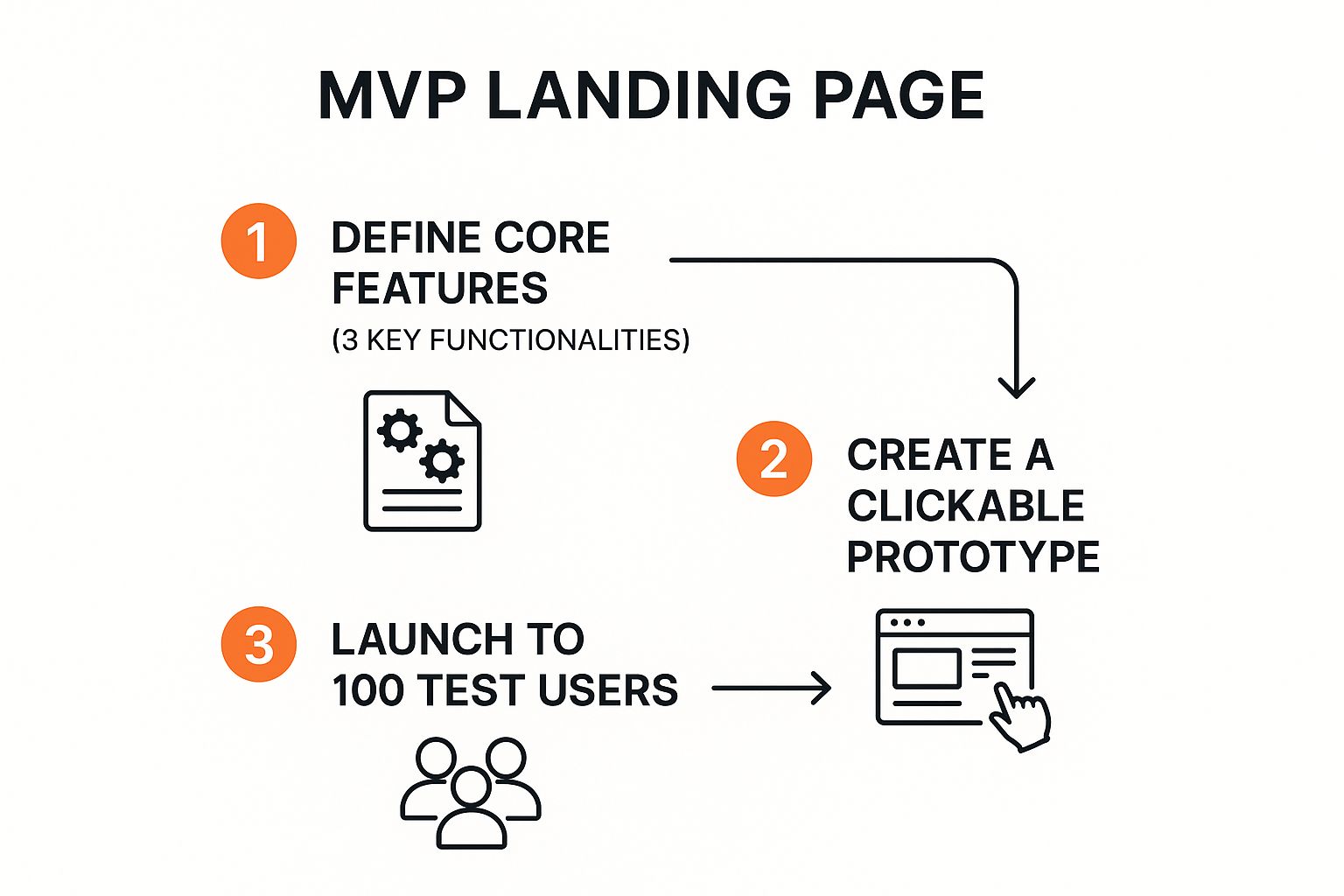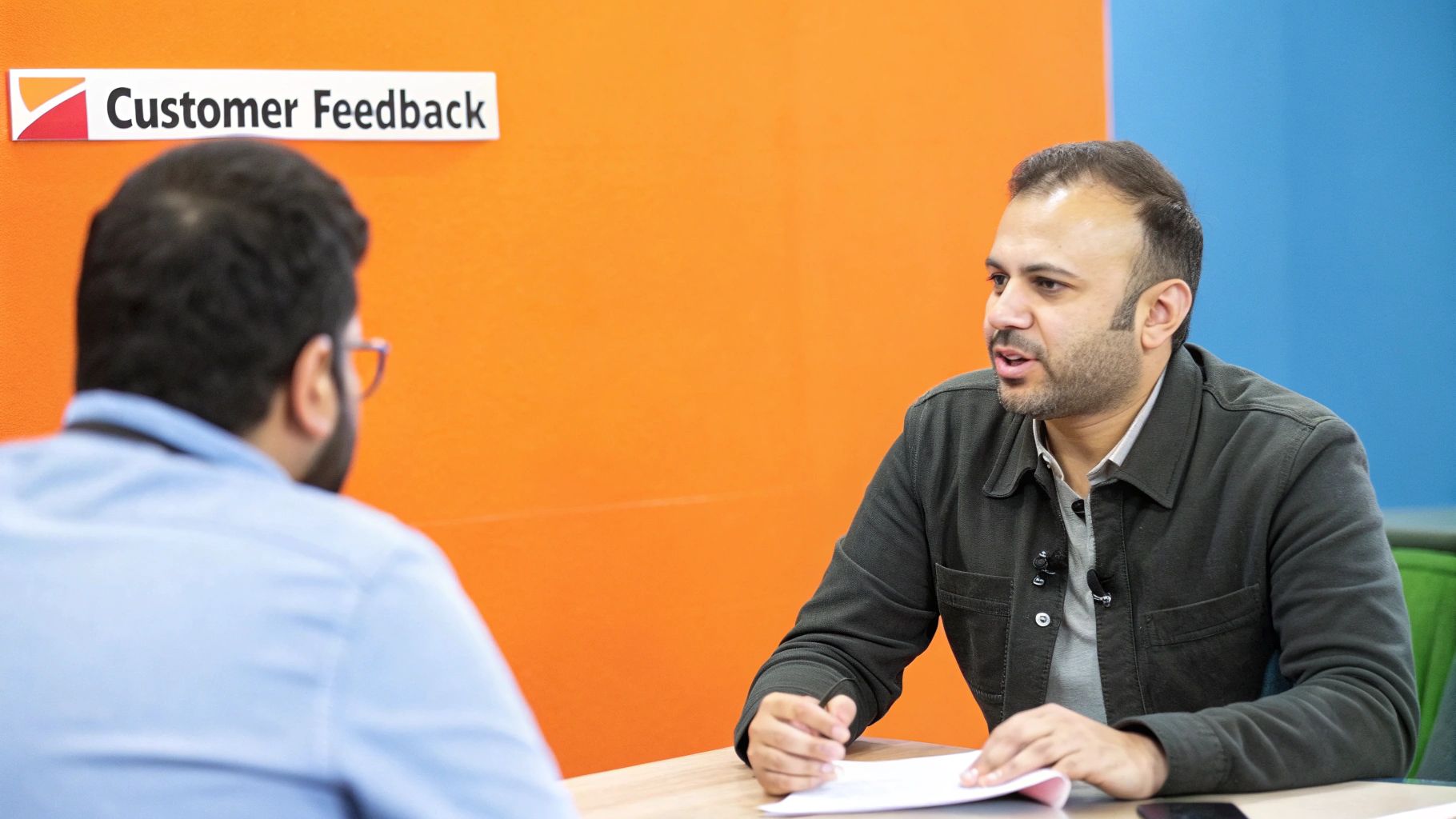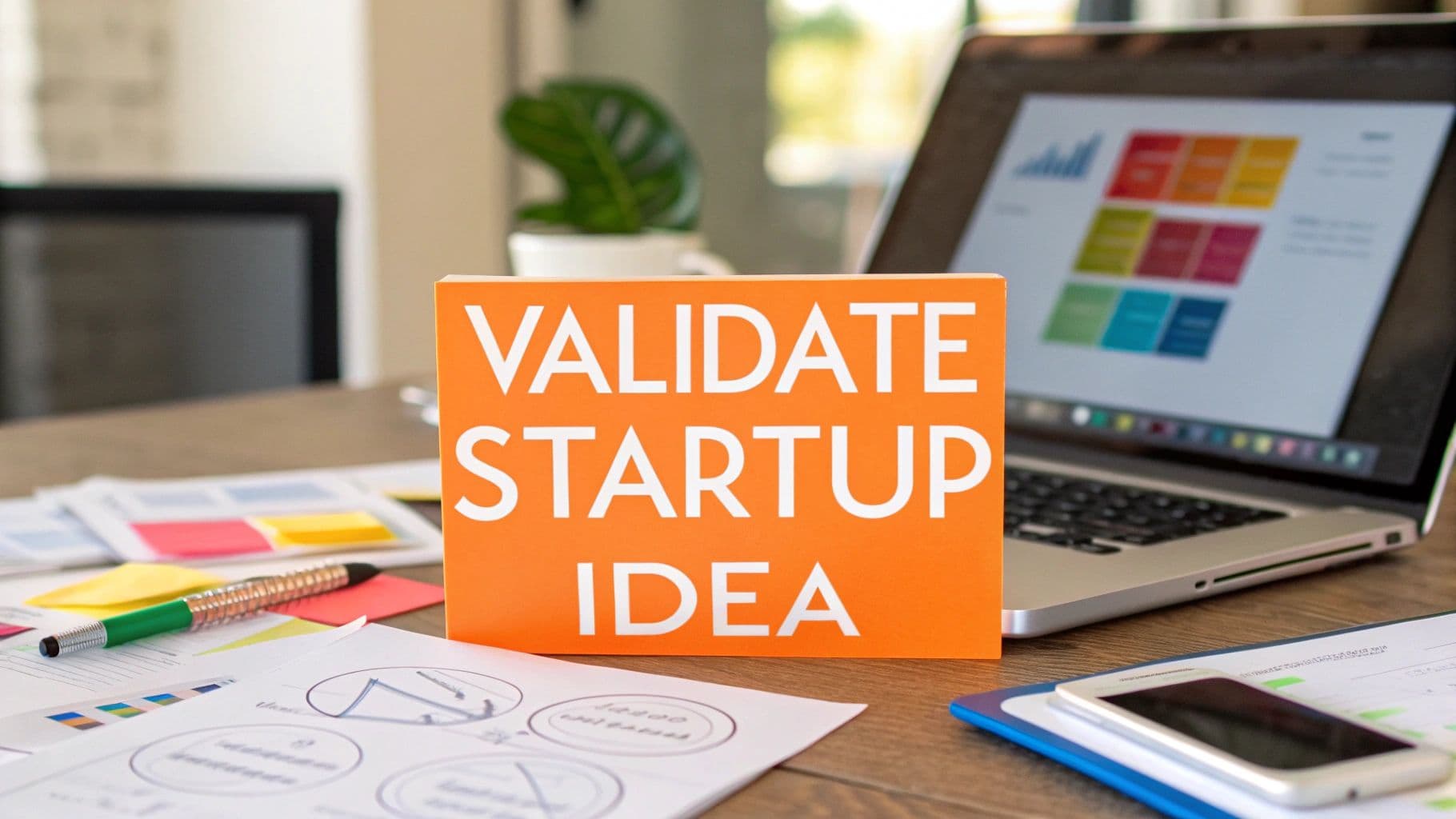So, you have a brilliant idea for a startup. It feels like a sure thing, a game-changer. That passion is essential, but it can also be a blind spot. Before you pour your heart, time, and savings into building something, you need to answer one tough question: does anyone actually want this?
This is the essence of idea validation. It’s not about getting pats on the back for a clever concept. It’s about methodically stress-testing your assumptions to see if there's a real, painful problem that people are desperate to solve. It’s about finding out if they’re willing to pay for your solution before you've written a single line of code.
Why Most Startups Fail and How Validation Can Save Yours
Let's be real—the "build it and they will come" philosophy is a recipe for disaster. I’ve seen countless founders fall into this trap, driven by an unshakeable belief in their product, only to launch to the sound of crickets. It's the quickest way to join the startup graveyard.
Think of validation as your venture's insurance policy. It’s a strategic process that shifts your focus from building a product to de-risking the business. You systematically replace your gut feelings and assumptions with cold, hard evidence from the people who will ultimately sign the checks: your future customers.
The Sobering Reality of Startup Survival
The statistics don't lie, and they paint a stark picture. A staggering 90% of startups fail. When you dig into why, the reason becomes painfully clear. According to recent research, 34% of these failures happen because the founders built something with no real market need. Let that sink in. Over a third of failed companies died because they created a solution for a problem that didn't exist, at least not in a way that people would pay to fix.
You can learn a lot by looking at these startup failure statistics, as they highlight the common pitfalls founders face.
Validation forces you to seek truth, not just confirmation. It’s about asking the hard questions right at the start:
- Is the problem real? Are people actively looking for ways to solve this, or is it just a minor inconvenience?
- Is the market big enough? Can you build a sustainable business around this, or are you targeting too niche of an audience?
- Is my solution the right one? Does what I'm planning to build actually resonate with the people who have this problem?
Answering these questions turns your assumptions into facts. It’s the difference between gambling on a guess and making an informed investment in your own future. This evidence-based approach protects your most valuable resources—time and money—ensuring that when you finally do build, you’re creating something people are not just happy to use, but eager to buy.
Before diving into the practical steps, it helps to internalize the foundational concepts of validation. Think of them as the pillars supporting your entire process.
The Core Pillars of Startup Idea Validation
| Pillar | Description | Key Question to Answer |
|---|---|---|
| Problem-Solution Fit | This is the initial connection. It's confirming that you've identified a real, significant problem and that your proposed solution directly addresses it. | "Does my solution solve a problem people genuinely care about?" |
| Market Viability | This pillar moves beyond the problem to the business potential. It assesses whether there are enough people with this problem who are willing to pay for a fix. | "Is there a large enough group of paying customers to build a sustainable business?" |
| Product-Market Fit | The ultimate goal. This is achieved when you have a product that not only solves the problem but does so in a way that delights a viable market, creating vocal advocates. | "Are people so happy with my solution that they're recommending it to others?" |
Grasping these three pillars gives you a clear framework. Each step of the validation journey, from initial research to your first sale, is about gathering evidence to strengthen these pillars and build a solid foundation for your startup.
Finding Real Problems People Actually Want Solved

Look, great companies don't just spring from a founder’s random "aha!" moment. They're forged by solving real, nagging problems for a specific group of people. But where do you find these golden opportunities?
Forget sterile brainstorming sessions or expensive focus groups. The most valuable insights come from observing people in their natural habitats. You have to become a sort of digital anthropologist, embedding yourself in the communities where your potential customers are already talking about their frustrations.
Online forums, niche social media groups, and especially Reddit are treasure troves of unfiltered, honest feedback. This is where you'll find the raw material for a truly valuable business idea.
Tuning Into Community Frustrations
I've seen it time and time again—savvy indie hackers and bootstrapped founders treat Reddit like a primary source for market research. Why? Because communities like r/SaaS, r/indiehackers, and r/smallbusiness are filled with people openly venting about their biggest headaches. They're complaining about clunky software, wishing for tools that don't exist, and detailing the elaborate, time-sucking workarounds they've cobbled together.
Those aren't just complaints. They're direct invitations to build something better.
The obvious challenge is the noise. Manually digging through thousands of posts and comment threads to find a pattern is an absolute grind. It’s tedious, inefficient, and it's easy to lose the signal in all the static.
This is where you need to work smarter, not harder. A handful of tools are designed specifically for this kind of granular, problem-first research.
This approach flips the script on validation. Instead of starting with an abstract idea and searching for a problem, you start with a documented problem and the very people experiencing it. It’s a direct line to your first conversations.
From Raw Data to a Real Starting Point
Modern tools can take this chaotic discovery process and streamline it, turning hours of aimless scrolling into a focused, actionable report. This is precisely what a tool like ProblemSifter was built for. It scans targeted subreddits and surfaces the recurring problems people are desperate to solve.
What makes this method so potent for early-stage validation is the quality of the insights you get. It’s not just high-level trends; it’s tangible evidence. You walk away with:
- Verbatim Problem Statements: You get the exact words people use to describe their pain points, which is invaluable for marketing copy and product development.
- Direct Source Links: You can click through to the original Reddit thread to see the full context, the nuances, and what other solutions have already been suggested (and shot down).
- A Built-in Lead List: Unlike other tools, ProblemSifter doesn’t just suggest ideas—it connects you to the exact Reddit users asking for them, giving you an immediate list of warm leads for your first interviews.
You’re no longer operating on a hunch. You're starting your journey with documented proof that the problem is real, painful, and being actively discussed.
A Bootstrapper-Friendly Path to Validation
For founders watching every dollar, this approach is a game-changer. Most traditional market research platforms are saddled with hefty monthly subscriptions that just don't make sense when you're pre-revenue.
A newer, more accessible pricing model is a much better fit. For instance, with ProblemSifter, you can get lifetime access to a curated report from a specific community for a one-time payment. For just $49, you can get lifetime access to a curated list of real startup problems people are discussing in one subreddit, or get a bundle of three for $99.
There are no subscriptions or hidden fees. It’s an incredibly efficient way to find a validated problem and your first potential customers, all in one shot.
Gaining Crucial Insights Through Customer Interviews

So you've spotted a problem in the wild. That's a great start, but it's just an observation. Now it's time to dig in and confirm if it’s a real, painful problem through qualitative research. This is where customer discovery interviews come in, and your job isn’t to sell your idea—it’s to listen. Your goal is to understand their struggle so deeply you could explain it back to them better than they can.
These conversations are where you find the truth. You're not looking for polite agreement or a list of feature requests. You’re on a hunt for the raw, unfiltered story behind their frustrations, the clunky workarounds they’ve cobbled together, and the actual emotional cost of the problem.
Finding and Persuading Your First Interviewees
Your first interviewees are absolutely crucial. You need to talk to people who are actively dealing with the specific pain point you’ve identified. If you’ve been lurking in Reddit communities, you’re already a step ahead.
This process is even smoother for founders who have used a tool like ProblemSifter. The platform doesn't just surface abstract ideas; it connects you directly to the Reddit users who were asking for a solution in the first place. This gives you a hand-picked list of people to contact for your initial round of interviews.
When you do reach out, be direct and respectful. Frame it around what’s in it for them: a chance to finally be heard by someone who is trying to build a solution. A simple, personalized message showing you read their post and understood their issue can work wonders.
Key takeaway: The point of these first conversations isn't to validate your solution; it's to validate the problem. Focus entirely on their past behavior, not on hypothetical futures. Ask, "How did you solve this last time?" not "Would you pay for a tool that did X?"
Crafting Questions That Uncover the Truth
The insights you get are only as good as the questions you ask. You have to fight the urge to ask leading questions that steer people toward the answer you want. Instead, stick to open-ended prompts that get them talking and telling stories.
Here are a few questions I’ve found incredibly effective:
- "Could you walk me through the last time you had to deal with [the problem]?" This forces them to recall specific details and the emotions tied to that experience.
- "What have you already tried to fix this? What did you like or dislike about those attempts?" This is pure gold. It reveals their motivation level and highlights the weaknesses of existing solutions.
- "If you had a magic wand and could change just one thing about this process, what would it be and why?" This helps you pinpoint the most painful part of their struggle.
You don't need dozens of these interviews to see a pattern. After just three to five solid conversations, you should have a gut feeling about whether the problem is real and if people are desperate for a better way.
As you analyze your notes, you'll start noticing recurring themes, frustrations, and powerful quotes. This is the foundation of your value proposition. These insights will guide every decision you make as you move toward building a prototype. To learn more about this, check out our guide on how to truly understand customer needs.
Testing Your Solution with Prototypes and MVPs
So, you've done the interviews and confirmed you're sitting on a real, painful problem. The temptation is to dive headfirst into coding and build the whole thing.
Stop. Resist that urge.
This next phase isn't about building your final product. It’s about testing your proposed solution with the absolute smallest investment of time and money possible. We're moving from conversations to concrete experiments.
Your toolkit here is broad, ranging from a simple landing page to interactive mockups, or even a basic Minimum Viable Product (MVP). The trick is to stay laser-focused on the "minimum" and "viable" parts of that equation. What's the leanest experiment you can run to get real, meaningful data on whether your solution actually hits the mark?
This kind of discipline is your best defense against the classic trap of building something beautiful that no one actually wants. For indie hackers and solopreneurs, where time and cash are everything, it's not just a good idea—it's survival.
From Smoke Tests to Functional Prototypes
You don't need a single line of code to start testing your solution. One of the most powerful early experiments is a simple "smoke test" landing page.
Here’s how it works:
- Create a one-page website that clearly explains your value proposition.
- Include a single, clear call-to-action, like "Join the Waitlist" or "Get Early Access."
- Drive a small, targeted amount of traffic to it.
The results will speak for themselves. If conversions are low, it's a strong signal that you need to rethink your pitch or the solution itself.
For ideas with more complex workflows, an interactive prototype is your best friend. Using a tool like Figma, you can build a clickable, simulated version of your app. Put it in front of potential users and just watch. You’ll see exactly where they get confused, which features they naturally gravitate towards, and if they "get" the core concept—all without any engineering overhead.
This flow chart breaks down the process of setting up an MVP landing page test perfectly.

The real insight here is the methodical progression. You define the core features, launch to a small, controlled group, and validate each step before you even think about moving to the next.
The Power of the High-Fidelity Test
Sometimes, a static page or a simple mockup just can’t capture the magic of your solution. A legendary example of this is Dollar Shave Club. They didn't have a sophisticated logistics empire on day one. Instead, they validated their entire subscription razor business with a single, hilarious video.
That simple, funny video generated 12,000 orders in the first 48 hours. It was undeniable proof of market demand, long before the backend was ready for primetime. This kind of systematic validation is what empowers you to make smart bets and reduce uncertainty as you build.
An MVP is not a cheaper, buggier version of your final product. It is an experiment designed to answer a specific question: "Will people use (and pay for) this core feature?"
Your MVP should do one thing, and do it exceptionally well: solve the single most painful part of the problem you’ve uncovered. By ruthlessly cutting all the "nice-to-have" features, you force yourself to focus on the absolute core value. This isn't just a development strategy; it's a critical milestone on your journey to find true product-market fit. The feedback you gather from these early, scrappy experiments will be the most valuable compass you have.
Measuring What Matters for True Validation

Good conversations are a great start, but true validation comes down to real commitments. This is the point where you have to stop relying on feelings and start tracking hard numbers that prove people genuinely want what you're building.
It's easy to get distracted by vanity metrics. A flurry of social media likes or a stream of positive comments might feel validating, but they don't build a business. The signals that really count are the ones that require a potential customer to make a small sacrifice—either of their time or, even better, their money.
These are the metrics that build a real business case, one founded on evidence, not just hope.
Tracking Signals of True Commitment
Strong validation signals force a potential customer to put some skin in the game. This is how you separate polite encouragement from a burning, wallet-opening need. Your focus should zero in on these key indicators:
- Landing Page Sign-Up Rates: When someone gives you their email, they're raising their hand and showing tangible interest. A 5-10% conversion rate from well-targeted traffic is a solid benchmark to aim for.
- Prototype Engagement: Are people successfully completing the main task in your interactive prototype? High completion rates are a strong sign that your solution is intuitive and actually solves the problem you think it does.
- Waitlist Commitments: How many people are willing to formally join your waitlist? This isn't just a number; it's your initial group of eager customers waiting for you to launch.
- Pre-Orders: This is the gold standard of validation. When someone pays for a product before it even exists, you’ve confirmed the problem, your solution, and your price point all at once.
The principle is simple: the more friction a user is willing to push through—giving an email, spending 10 minutes on a prototype, paying money—the stronger your validation. This is how you prove demand with data.
Setting Clear Benchmarks for Success
Before you run a single ad or send a single email, you must define what success actually looks like. If you don't set clear benchmarks, you're just collecting data without any real purpose. You need a line in the sand that helps you decide whether to push forward, pivot, or pull the plug.
For instance, you might set a specific goal: get 100 email sign-ups from your landing page in two weeks from a specific professional audience. If you only get 10, that’s not a failure—it's a clear signal that your value proposition isn't hitting the mark.
Learning to interpret these results objectively is what separates successful founders from those who are just guessing how to validate a startup idea. This early data is your compass. It tells you whether you're heading in the right direction or if it's time to go back to the drawing board and question your core assumptions.
This data-first mindset is foundational. You can dive deeper into this initial discovery phase by learning how to start conducting market research properly. It’s all about methodically turning your assumptions into testable hypotheses, laying a solid, evidence-based foundation for your business.
Answering Your Nagging Startup Validation Questions
Even with the best roadmap, wading into the validation process can feel like you're navigating in the dark. It’s completely normal to have questions and second-guess yourself. This is part of the process. Let's tackle some of the most common hang-ups I see founders—especially indie hackers and solopreneurs—struggle with when they're trying to figure out if their idea has legs.
How Do I Know When I've Done Enough Validation?
This is the million-dollar question, isn't it? The hard truth is there's no magic number or a universal checklist that screams, "You're done!" The goal isn't to eliminate every last shred of uncertainty—that’s impossible. Instead, think of it as systematically chipping away at your biggest, most glaring assumptions.
I've found you've probably done enough legwork when two things start happening.
First, you hear the same problem described back to you, in different words, by different people in your target market. Crucially, this happens without you having to lead them there. Second, you have some kind of tangible proof that a real chunk of these people are willing to give you something of value. This could be their email address (a solid landing page should see a 10-15% conversion rate), their time for an in-depth demo, or the holy grail: their credit card for a pre-order.
A good rule of thumb: You've hit a solid validation milestone when you can clearly state the specific problem for a specific customer and have concrete evidence that they're willing to act on your proposed solution.
What If Someone Steals My Idea While I'm Validating It?
I get it. This fear feels huge when you're starting out, but honestly, it’s almost always overblown. The risk of you building something absolutely no one wants is infinitely greater than the risk of someone swooping in and stealing your concept. Ideas are a dime a dozen; what's truly rare and difficult to copy is disciplined, relentless execution.
By talking openly with potential customers and sharing the problem you're tackling, you're actually building a competitive advantage. You're gathering firsthand insights, building relationships, and creating a small but loyal community of early believers. A competitor can't just replicate that deep user understanding and initial goodwill overnight. The feedback you gain from being open is far more valuable than any "protection" you get from secrecy.
Can I Really Validate an Idea if I Don't Have a Technical Co-Founder?
Not only can you, but you absolutely should. The earliest stages of validation have nothing to do with code and everything to do with the problem and the solution concept. You can test your most critical hypotheses surprisingly well with a handful of no-code or low-code tools.
- Landing Pages: Spin up a "smoke test" page with a tool like Carrd or Webflow. Describe the solution, capture emails, and see who's interested.
- Interactive Prototypes: Use something like Figma or Balsamiq to build clickable mockups. This lets you test the user flow and get feedback without writing a single line of code.
- Concierge MVP: This is my favorite. Manually perform the service for your first few customers. You act as the "software" to deliver the promised outcome. It’s the ultimate proof that people will pay for the value you're offering, and it gives you incredible leverage later on when you're looking to bring on a technical partner or fund development.
Where Do Tools Like ProblemSifter Fit into All This?
Think of a tool like ProblemSifter as a massive shortcut for the most critical first step: finding a genuine problem that's actually worth solving. Instead of just throwing generic ideas at you, ProblemSifter connects you directly to the Reddit users who are literally asking for solutions. It mines communities for raw, unfiltered pain points, giving you not just an "idea," but the original post and the usernames of the people experiencing that exact problem.
This approach is powerful for two reasons. First, you start with a validated problem, not a guess. Second, it gives you a list of real people to interview and, eventually, a targeted group to promote your solution to. For a one-time cost of $49 for lifetime access to one subreddit (or $99 for three), it's an incredibly efficient way for an indie hacker to find an idea and instantly identify a list of their first potential customers—all in one spot, with no monthly fees.
Ready to stop guessing and start building something people actually want? ProblemSifter turns Reddit into your personal startup idea engine, uncovering real user pain points so you can build with confidence. Find your validated startup idea today.
